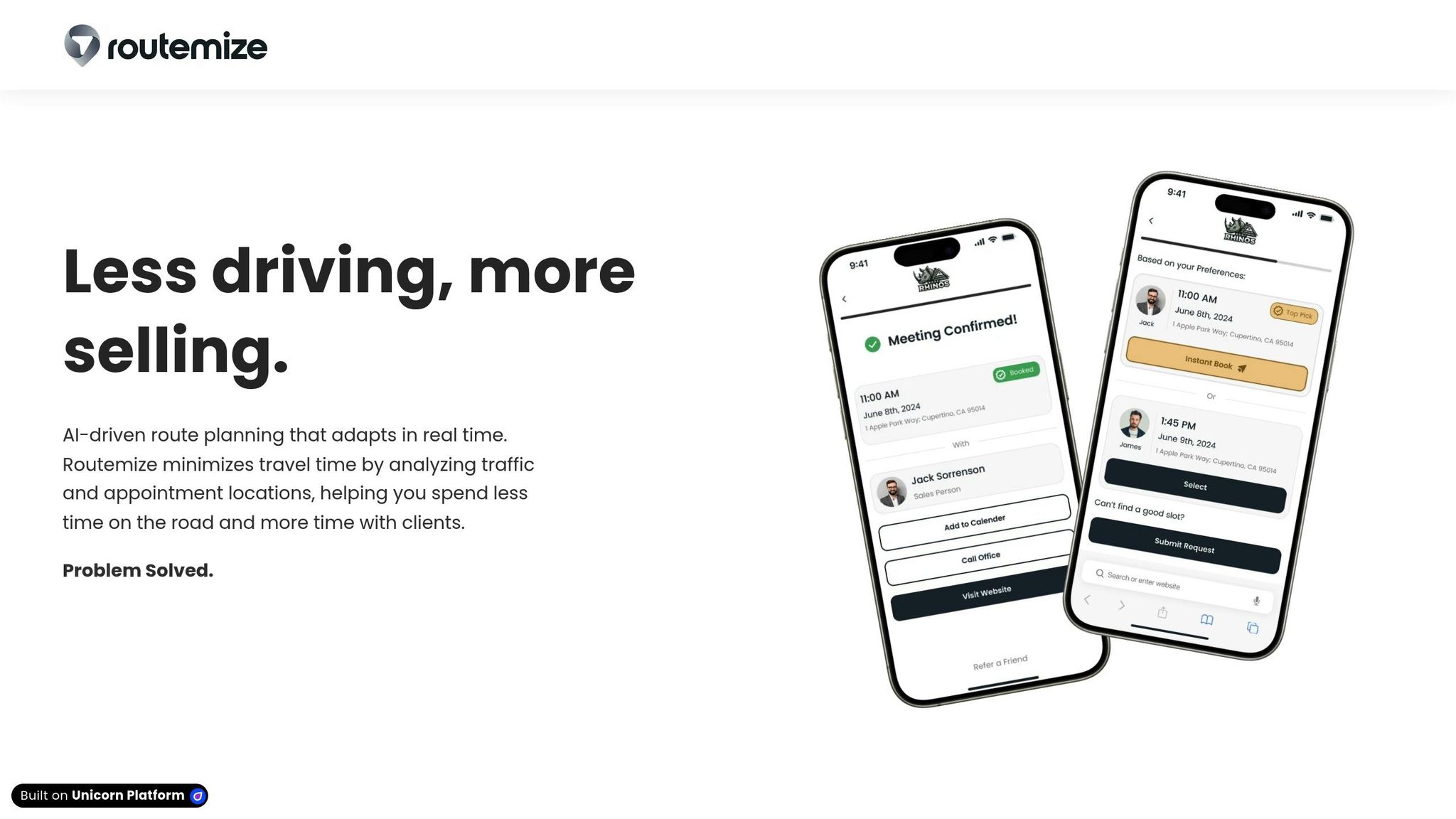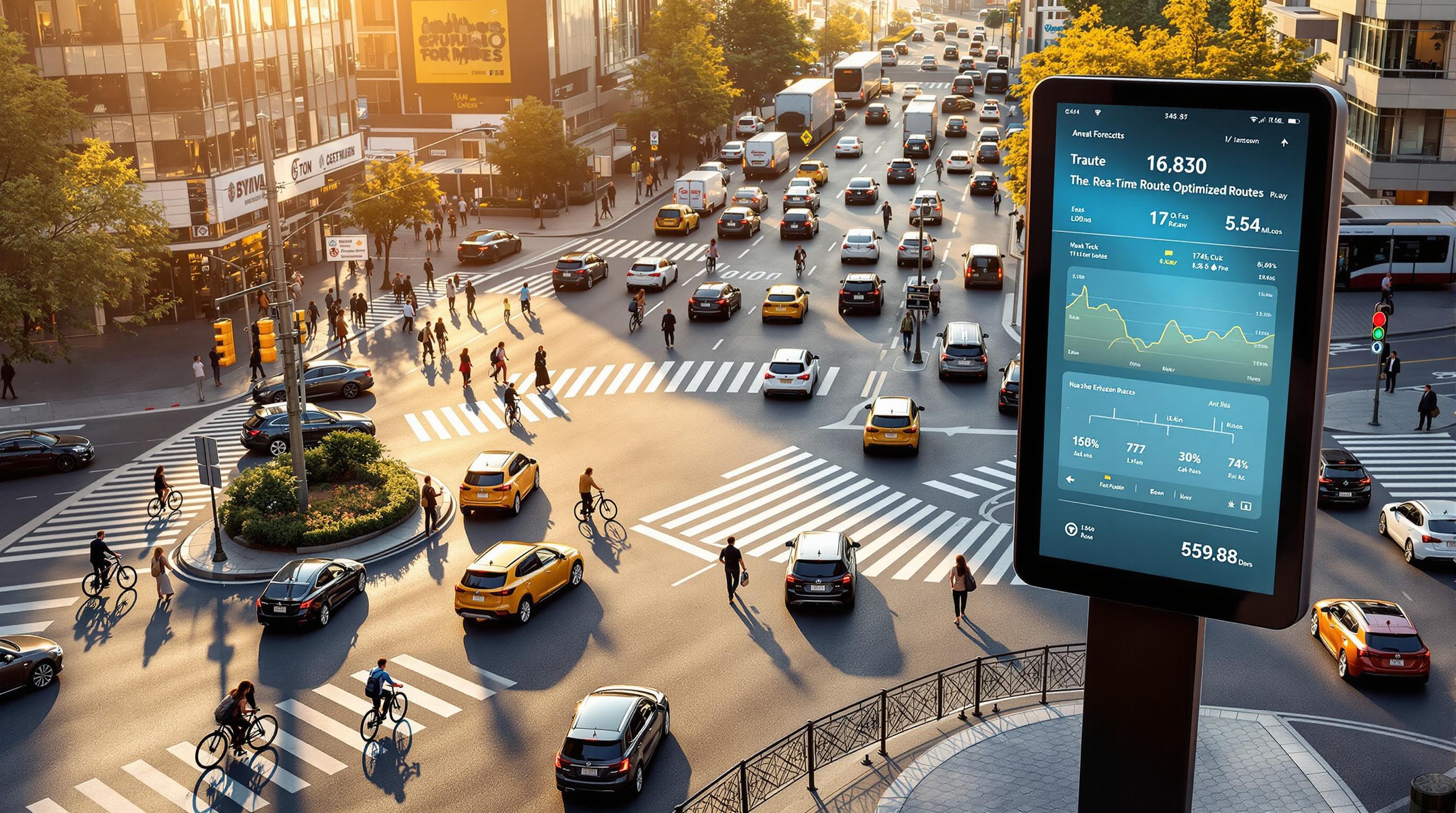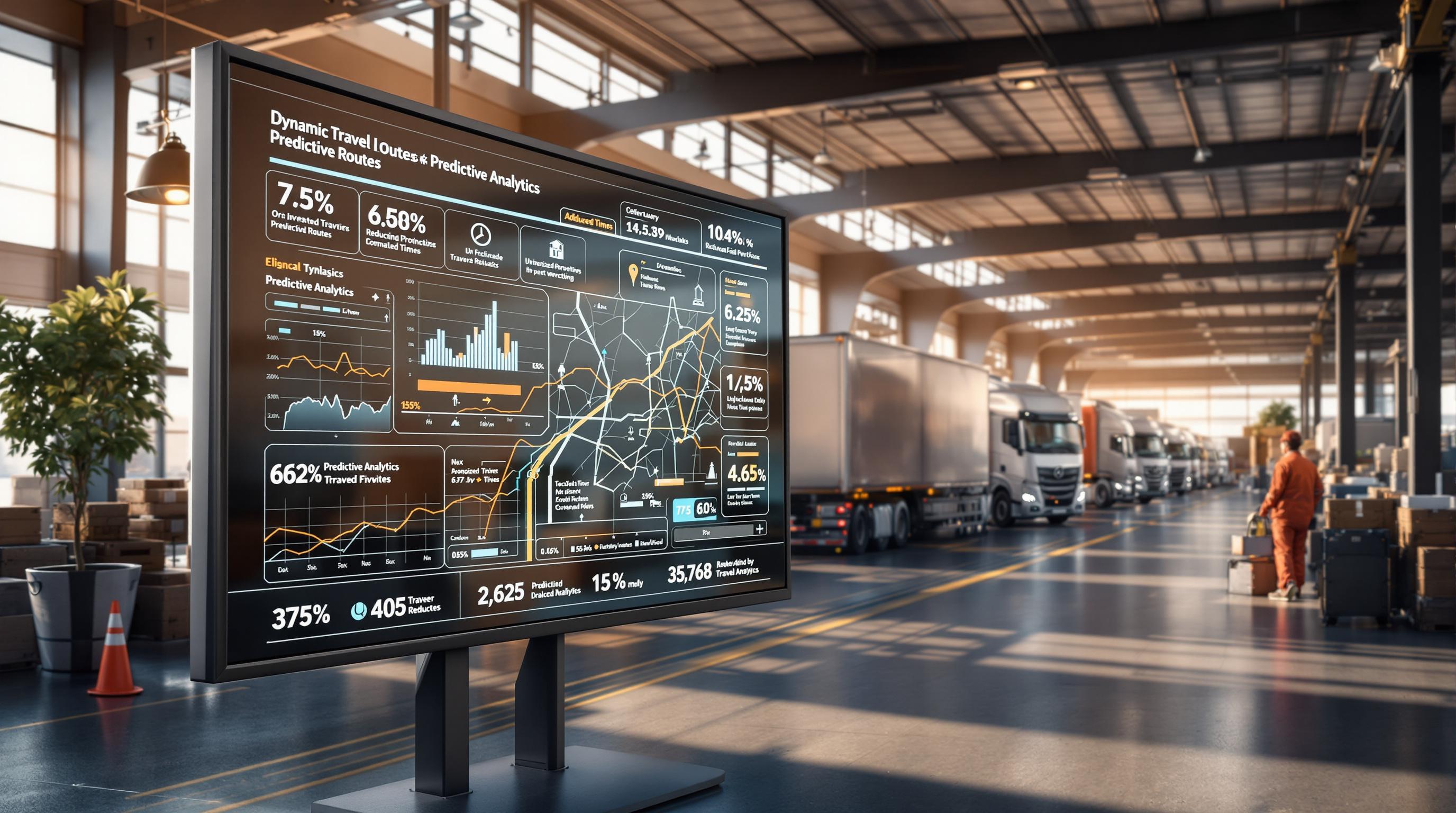Dynamic and static route planning are two approaches to managing delivery and fleet routes, each with distinct strengths and limitations. Here's a quick breakdown:
- Dynamic Route Planning: Adapts routes in real-time using live data like traffic, weather, and delivery changes. It improves efficiency by up to 40%, reduces delays by 25%, and saves 19% in costs. Ideal for large fleets and unpredictable schedules.
- Static Route Planning: Uses fixed, pre-planned routes based on historical data. It's reliable and cost-effective for small operations with consistent routes but lacks flexibility, leading to potential efficiency losses of up to 35%.
Quick Comparison
| Feature | Static Routes | Dynamic Routes |
|---|---|---|
| Traffic Adjustments | No automatic updates | Real-time rerouting |
| Flexibility | Limited | High |
| Cost Savings | Lower upfront costs | Long-term savings (19% avg) |
| Efficiency | Consistent but less adaptable | Up to 40% more efficient |
| Best For | Small fleets, predictable routes | Large fleets, dynamic environments |
Choosing the right method depends on your fleet size, delivery needs, and budget. Dynamic routing is better for complex, high-demand operations, while static planning suits simpler, stable delivery models.
Static vs Dynamic Routing: What's the difference? | Network Essentials
Static Route Planning
Static route planning involves organizing delivery routes based on fixed, unchanging paths. This approach works best for fleets with predictable schedules and consistent customers. Routes are designed using historical data, fixed customer locations, delivery timeframes, known traffic trends, and vehicle capacities. While these routes can be updated manually when necessary, their primary appeal lies in their stability and reliability, which come with several operational perks.
Benefits of Static Routes
Static route planning creates a dependable system that promotes efficiency through consistency. Here’s a closer look at its main benefits:
| Benefit | Description |
|---|---|
| Operational Consistency | Familiar routes minimize navigation mistakes. |
| Customer Relationships | Regular contact strengthens customer connections. |
| Resource Management | Predictable schedules simplify vehicle loading and inventory planning. |
| Cost Efficiency | Lower reliance on advanced technology reduces costs. |
| Route Familiarity | Drivers’ familiarity with routes helps prevent unexpected issues. |
Static Route Constraints
While static routes offer many advantages, they also come with limitations. Research indicates that static route planning can result in up to a 35% efficiency loss compared to real-time optimized routes. These routes lack flexibility, making it harder to adapt to sudden road closures, unexpected traffic jams, or urgent delivery requests. Additionally, the inability to adjust to changing conditions can lead to higher fuel consumption. To maintain efficiency, businesses are advised to review and adjust their static routes at least once every two months.
Dynamic Route Planning
Dynamic route planning uses live data and advanced algorithms to continuously adjust routes. This approach ensures routes stay efficient and responsive, even as conditions change throughout the day.
How Dynamic Systems Work
Dynamic routing relies on AI and machine learning to process multiple data streams at once. These systems evaluate a variety of factors, such as:
| Factor | Impact on Routing |
|---|---|
| Real-time Traffic | Avoids congestion by suggesting alternate routes |
| Weather Conditions | Adjusts arrival times for delays caused by weather |
| Vehicle Availability | Reassigns loads based on fleet capacity |
| Customer Time Windows | Reschedules stops to meet delivery deadlines |
| Road Closures | Automatically calculates detours |
This constant analysis ensures smoother operations and better outcomes.
Why Dynamic Routes Matter
Dynamic route optimization offers measurable improvements for logistics operations:
- 40% greater efficiency compared to routes designed by experienced planners
- 25% fewer delivery delays, increasing reliability
- 18% higher on-time delivery rates, boosting customer satisfaction
- 19% average cost savings compared to static planning methods
For instance, if a customer updates their delivery time from 2:00 PM to 3:00 PM at 1:30 PM, the system immediately adjusts all remaining stops to maintain overall efficiency while accommodating the change.
Challenges in Dynamic Routing
While the benefits are clear, implementing dynamic route systems comes with hurdles:
-
Technical Infrastructure:
Companies need IT systems capable of processing diverse data types, secure encryption to protect sensitive information, and efficient storage solutions to manage the data flow. -
Cost Considerations:
Initial setup involves expenses for software, hardware, training, and system integration. -
Operational Adaptation:
Teams must be trained to use the system effectively, workflows need to be adjusted, and real-time data accuracy is crucial. Clear communication with customers is also key to ensuring a seamless experience.
Despite these challenges, experts agree that the investment in dynamic routing pays off. Companies benefit from lower fuel costs, increased productivity, and better delivery capacity, making it a worthwhile upgrade.
sbb-itb-7020db0
Static vs. Dynamic Routes
Let’s dive into how static and dynamic route planning handle real-world challenges. By comparing these two approaches, we can better understand their impact on fleet performance and overall efficiency.
Real-Time Response
Static routes stick to a pre-set plan, no matter what happens on the road. In contrast, dynamic systems adapt on the fly. For example, real-time traffic updates can alter the best route by as much as 35% when compared to static planning, according to industry data.
| Response Factor | Static Routes | Dynamic Routes |
|---|---|---|
| Traffic Changes | No automatic adjustment | Immediate rerouting |
| Weather Events | Manual updates needed | Automatic adaptation |
| Vehicle Breakdowns | Requires manual intervention | Rapid rerouting |
| Customer Changes | Manual rescheduling | Instant reoptimization |
Cost Analysis
Dynamic route optimization isn't just about convenience - it also delivers measurable savings. On average, it can cut costs by 19% compared to static planning. Additionally, it reduces total distance traveled by 22%, which translates to lower fuel and maintenance expenses.
Here are two key factors to consider:
- Operational Expenses: Static routes may save on upfront technology costs, but they often lead to higher ongoing expenses due to inefficiencies. Dynamic systems, while requiring an initial investment in software and training, pay off in the long term by optimizing resources.
- Resource Allocation: Dynamic routing boosts vehicle utilization and minimizes idle time, leading to a 53% increase in productivity. This also helps reduce overtime costs and ensures better use of your fleet.
Fleet Size Impact
The size of your fleet plays a big role in determining whether static or dynamic planning is the better fit. As fleets grow, dynamic routing becomes increasingly valuable, while static planning is often better suited for smaller operations.
| Fleet Size | Static Planning | Dynamic Planning |
|---|---|---|
| Small (1–5 vehicles) | Manageable manually | May be cost-prohibitive |
| Medium (6–20 vehicles) | Limited scalability | Optimal efficiency gains |
| Large (20+ vehicles) | Difficult to maintain | Significant ROI |
When to Use Each Method
Choosing between static and dynamic routing depends on your business's specific needs and circumstances.
Static route planning is ideal for:
- School bus routes that follow fixed schedules
- Regular deliveries in low-traffic areas
- Small operations with predictable customer locations
- Businesses with tight technology budgets
Dynamic route planning shines in:
- Urban delivery scenarios where traffic is unpredictable
- On-demand services that require flexibility
- Managing large fleets with complex logistics
- Operations with variable customer demands
These comparisons pave the way for understanding how tools like Routemize harness dynamic routing to provide real-time fleet optimization.
Routemize Features

Discover how Routemize uses AI to streamline delivery operations.
Main Functions
Routemize provides real-time route optimization, adjusting to ever-changing conditions. Using advanced AI algorithms, it evaluates factors like traffic, weather, and delivery windows to craft efficient routes:
| Feature | Dynamic Capability | Business Impact |
|---|---|---|
| Traffic Analysis | Monitors real-time traffic conditions | Cuts travel time by avoiding congestion |
| Weather Integration | Accounts for adverse weather | Ensures consistent delivery performance |
| Schedule Optimization | Adjusts appointment spacing dynamically | Increases stops per route while meeting deadlines |
| Live Tracking | Tracks vehicles in real time | Enhances dispatch coordination and customer communication |
By leveraging real-time data, Routemize helps reduce fuel usage, speed up deliveries, and cut overall transportation costs.
Small Business Solutions
For small businesses, transitioning from manual to automated route planning can feel daunting. Routemize simplifies this process with features designed to address common hurdles:
-
Automated Route Building
Say goodbye to manual planning. Routemize automates the process, saving time and ensuring efficient delivery schedules. -
Customizable Implementation
Whether you're in local deliveries or field services, the platform adjusts to your needs, offering tailored settings that fit your business. -
Cost-Effective Scaling
Designed to grow alongside your business, Routemize helps you scale operations while improving productivity - often covering initial costs through increased efficiency.
Setup Guide
Getting started with Routemize is simple and user-friendly:
-
Initial Configuration
- Upload your customer database.
- Set your business hours.
- Define service areas and zones.
-
Driver Onboarding
- Install the Routemize mobile app.
- Provide basic navigation training.
- Set up communication preferences.
-
System Integration
- Link Routemize with your existing business tools.
- Configure reporting and notifications.
- Finalize system settings.
The platform’s intuitive design makes it easy for both dispatchers and drivers to adapt. With these tools, businesses can shift from rigid planning to dynamic, real-time optimization, boosting efficiency and staying competitive.
Summary
Dynamic route optimization has proven to be a game-changer for fleet efficiency and cost management. It can create routes that are up to 40% more efficient than those planned manually. This efficiency leads to a 22% reduction in total distance traveled and an average cost savings of 19% when compared to static planning methods.
Here’s how dynamic routing stacks up against static planning across key metrics:
| Metric | Dynamic Route Impact | Static Route Impact |
|---|---|---|
| Productivity Increase | Up to 53% | Limited by fixed route planning |
| Delivery Delays | 25% reduction | Subject to fixed schedules |
| Enhanced Customer Feedback | 16% higher scores | Varies with consistent patterns |
| On-Time Deliveries | 18% improvement | Dependent on predetermined routes |
These metrics highlight the operational advantages dynamic routing brings to the table.
"Efficient routing has become a cornerstone of modern logistics, with enterprises across B2B and B2C sectors increasingly relying on advanced strategies to optimize delivery operations." - Komal Puri, AVP Marketing at FarEye
With 80% of customers expecting same-day or next-day delivery, businesses must adopt solutions that can respond swiftly to real-time conditions. For instance, traffic updates alone can shift optimal routes by up to 35% compared to static plans. This underscores the importance of flexible systems that can adapt on the fly.
Routemize, an AI-powered platform, exemplifies this approach. By analyzing real-time traffic and appointment data, it delivers the benefits of dynamic routing while significantly reducing planning time. This efficiency makes it easier for companies to meet the growing demand for quick and dependable deliveries.
Looking ahead, dynamic systems are poised to dominate route planning as they adapt seamlessly to changing conditions. The evidence clearly shows that dynamic routing is no longer optional - it's essential for modern fleet management, offering better customer satisfaction and lower operational costs.
FAQs
How does dynamic route planning use AI to optimize deliveries?
Dynamic route planning taps into the power of AI and machine learning to make deliveries more efficient. By analyzing real-time data - like traffic conditions, weather updates, and road closures - these systems can adjust routes instantly, helping drivers save time and cut down on fuel consumption.
Using historical data and predictive algorithms, AI tools also pinpoint the best routes while staying flexible enough to handle surprises like accidents or sudden schedule changes. The result? Operations run more smoothly, costs go down, and customers enjoy a better overall experience.
What challenges might businesses encounter when switching from static to dynamic route planning?
Switching from static to dynamic route planning isn’t without its challenges. One of the main obstacles is the upfront investment in both technology and training. For businesses accustomed to static methods, this can feel overwhelming. Dynamic routing also relies heavily on real-time data and the ability to process it efficiently, which often means upgrading existing systems and workflows.
Another hurdle is handling the added complexity that comes with dynamic routing. Unlike fixed routes, dynamic planning constantly adapts to variables like traffic patterns, delivery time windows, and even weather conditions. This requires not only operational changes but also a shift in mindset across the organization to prioritize flexibility and quick decision-making.
Despite these challenges, businesses willing to make the leap often find the rewards - like greater efficiency and shorter travel times - well worth the effort.
When is static route planning a better choice for small businesses compared to dynamic route planning?
Static route planning is a great fit for small businesses with steady delivery schedules and fixed destinations. It shines in situations where traffic patterns are predictable and routes remain stable, enabling businesses to create reliable delivery plans without constant updates.
Take, for instance, businesses that serve the same customers on a regular basis. By using historical data, they can establish static routes that streamline operations, cut down on planning time, and ensure dependable delivery schedules. This can be especially helpful for businesses working with limited resources. Plus, sticking to consistent routes over time can lead to cost savings and improved efficiency.


